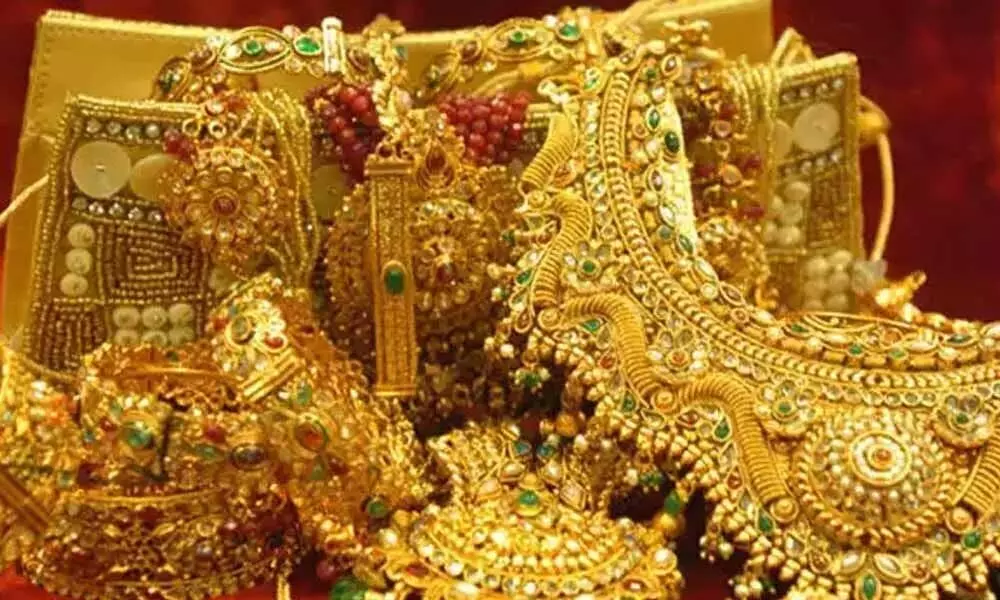Gold Rate Today 916 – 916 Gold Rate Today
The current gold rate in India stands at ₹5,415, specifically referring to the 22-carat gold rate. In India, the 22-carat gold rate is also commonly referred to as the 916 kdm gold rate, where “kdm” stands for “kadha, desi, masi,” indicating the traditional method of gold jewelry making. While there are several other varieties of gold available in the market, three varieties hold the highest appeal among people: 24-carat gold, 22-carat gold, and 18-carat gold. Let’s delve into these varieties and explore their pricing, demand, and calculation methods.
Firstly, 24-carat gold is the purest form of gold available, consisting of 99.9% gold content. Due to its high purity, it is highly sought after for investment purposes rather than jewelry making. However, it is important to note that 24-carat gold is relatively softer and more malleable, making it less suitable for intricate jewelry designs.
When you examine 22-carat gold closely, you’ll find that it consists of 91.6% gold and a combination of other metals like silver and copper. The additional metals provide the jewelry with durability and strength. This particular type of gold strikes a balance between purity and durability, making it a popular choice for both investment purposes and creating beautiful jewelry. The price of 22-carat gold is lower than that of 24-carat gold because it contains these extra metals.
On the other hand, 18-carat gold contains 75% gold and is mixed with other metals to enhance its strength and durability. Jewelry makers often use this variety to craft intricate and high-quality pieces. Due to its lower amount of pure gold, the price of 18 carat gold is lower compared to both 24-carat and 22-carat varieties.
The price of gold is influenced by various factors, such as global market trends, supply and demand dynamics, economic conditions, and geopolitical factors. Gold rates are usually quoted per gram or per 10 grams and may vary across different cities due to local factors and taxes.
Gold Rate Today 916 – 916 Gold Rate Today
| 30th January 2024 | 1 gram | 8 grams | 10 grams | 12 grams (1 Tola) | 100 grams |
| 24 Carat Gold (Pure Gold Rate) | ₹5,907 -9.00 | ₹47,256 -72.00 | ₹59,070 -90.00 | ₹70,884 -108.00 | ₹5,90,700 -900.00 |
| 22 Carat Gold (Standard Gold Rate) | ₹5,415 -10.00 | ₹43,320 -80.00 | ₹54,150 -100.00 | ₹64,980 -120.00 | ₹5,41,500 -1,000.00 |
* The above-mentioned gold rates are approximate and do not include GST or other additional charges. To obtain precise rates, please consult your local jeweller.
Here are some of the factors that can affect the price of gold:
- Demand and supply: The price of gold is determined by the principles of supply and demand. As demand for gold increases, its price rises accordingly. Conversely, when demand decreases, the price of gold decreases as well.
- Interest rates: When interest rates are low, investors often turn to gold as a safe haven investment. As a result, the demand for gold increases and can drive up its price.
- Inflation: When inflation becomes high, the price of gold tends to go up because gold is seen as a hedge against inflation.
- Geopolitical events: When there are geopolitical events like wars or terrorist attacks, investors often seek safety in gold, causing its price to rise.
Significance of 916 gold
The significance of 916 gold lies in its purity and cultural importance. 916 gold refers to the gold alloy that contains 91.6% pure gold and 8.4% other metals, such as silver, copper, or zinc. This composition is also known as 22-carat gold. The term “916” represents the gold’s purity, indicating that it contains 916 parts of pure gold out of 1000 parts.
In many cultures, 916 gold holds great significance and is widely used for crafting exquisite jewelry pieces. Its popularity stems from the balance it strikes between purity and durability. The addition of other metals in the alloy enhances its strength, making it suitable for intricate designs and everyday wear. 916 gold is cherished for its intrinsic value and timeless appeal.
It is often associated with auspicious occasions, weddings, and festivals. Many people consider 916 gold as a symbol of wealth, prosperity, and social status. It holds sentimental value and is often passed down through generations as a family heirloom. When buying or selling gold jewelry, the 916 hallmark assures customers of its authenticity and purity.
The hallmark serves as a guarantee of the gold’s quality, as it is certified by authorized agencies or jewelry associations. The significance of 916 gold extends beyond its purity and monetary value. It is deeply ingrained in cultural traditions, customs, and rituals. Wearing 916 gold jewelry is seen as a way to connect with one’s heritage and showcase a personal style.

Factors that Affect 916 Gold Rate
Gold prices are influenced by various factors, both internal and external. To comprehend how these factors work, it is important to understand their impact on the fluctuation of gold prices. One key factor that affects gold rates is the demand for gold itself. When there is a high demand for gold, its prices tend to rise, and vice versa. Economic conditions, geopolitical events, and investor sentiment all contribute to the overall demand for this precious metal. For instance, during times of economic uncertainty, investors often turn to gold as a safe-haven asset, driving up its demand and consequently its price.
Another factor directly influencing gold rates is the supply of gold. Since the available amount of this precious material is limited, scarcity plays a significant role in increasing its price levels. The supply of gold depends on multiple factors such as mining production rate, recycling efforts, and central bank sales. Furthermore, changes in the value of the US dollar can also impact gold rates due to the fact that gold is priced in US dollars.
When the value of the US dollar declines relative to other currencies or economic circumstances weaken its worthiness globally., it typically leads to a rise in Gold prices and vice versa. Being aware of these key factors allows individuals interested in investing or predicting future trends in Gold rates make sound decisions based on comprehensive analysis
Historical Trends of Gold Rates
Gold has been highly valuable for centuries, with its price fluctuating throughout history. By examining historical trends in gold rates, we can gain valuable insights into how gold prices might behave in the future. In the last century alone, gold has experienced significant price movements. In the 1970s, as the US dollar weakened and investors sought safe-haven assets, gold prices soared.
However, during the 1980s and 1990s, global economic stability and falling inflation rates caused a decline in gold prices. In the early 2000s, geopolitical tensions and economic uncertainty led to another rise in gold prices.
The financial crisis of 2008 further boosted prices as investors turned to safe-haven assets like gold. Since then, gold prices have continued to fluctuate due to various factors such as economic conditions, geopolitical events, and investor sentiment. While past performance cannot guarantee future results, understanding historical trends can offer valuable insights into the potential future behavior of gold prices.

How to Read 1 gram Gold Rates
1-gram gold rates require understanding the key elements that influence the pricing and staying informed about the prevailing market conditions. Here are the steps to effectively read 1-gram gold rates:
- Determine the unit of measurement: Ensure that the gold rates you are referring to are specifically quoted per 1 gram. Gold prices can vary based on different units of measurement such as grams, ounces, or kilograms.
- Stay updated with live market rates: Monitor reliable sources of information like financial news websites, market platforms, or reputable gold dealers that provide real-time gold rates. These sources will display the current price per gram of gold.
- Understand the purity level: Gold is available in various purity levels, typically represented by karats (e.g., 24k, 22k, 18k). Each karat denotes the percentage of pure gold present in the alloy. Ensure that you are aware of the purity level associated with the quoted gold rate.
- Consider additional charges: Keep in mind that buying or selling 1 gram of gold may incur additional charges such as making charges, taxes, or dealer commissions. These factors can impact the overall cost or selling price of the gold.
- Compare rates across different sources: It’s advisable to compare the rates provided by multiple reliable sources to ensure you are getting the most accurate and competitive pricing for 1 gram of gold. This allows you to make well-informed decisions when buying or selling.
- Stay informed about market trends: Understand that gold prices can be influenced by various factors, including global economic conditions, geopolitical events, currency fluctuations, and supply and demand dynamics. Stay updated with market news and trends to gain insights into potential price movements.
- Utilize online calculators: Online gold rate calculators are available that can help you determine the approximate cost of 1 gram of gold based on the prevailing rate. These calculators take into account factors like purity, additional charges, and taxes to provide a more accurate estimate.
Understanding the Gold Market
The gold market is a complex and ever-changing market that is influenced by various factors. To grasp the intricacies of this market, it’s important to understand its mechanics and the different participants involved. Gold is traded globally, with prices fluctuating throughout the day based on market conditions. This market consists of miners, refiners, bullion dealers, investors, and central banks, each playing a role in shaping its dynamics.
The price of gold is determined by supply and demand forces, with shifts in both driving price fluctuations. Additionally, economic conditions, geopolitical events, and investor sentiment also impact the gold market. A deep understanding of this market is crucial for making informed investment decisions and navigating its complexities effectively.

The Pros and Cons of Investing in Gold
Including gold in your investment portfolio can offer several advantages, such as diversification and protection against inflation and economic uncertainty. Gold has a strong historical track record as a reliable store of value and a hedge against inflation over the long term. Its physical nature also provides a sense of security by allowing investors to hold assets outside of the financial system, safeguarding against market volatility. However, there are some drawbacks to consider when investing in gold.
Unlike other investments, gold doesn’t generate income, potentially causing missed opportunities for returns. Moreover, gold prices can be volatile, making it challenging to predict future performance accurately. It’s also essential to acknowledge that investing in gold comes with associated costs for buying and selling the asset. A comprehensive understanding of the pros and cons will encourage investors to make informed decisions regarding adding gold to their portfolios.
Different Forms of Gold Investments
There are several ways to invest in gold, each with its own advantages and disadvantages. One common method is through physical gold, such as coins or bars. Physical gold offers the security of being outside the financial system and protection against market volatility. However, it can be costly due to buying and selling fees, and storing and transporting it can be challenging.
Another option is investing in gold through exchange funds (ETFs). Gold ETFs allow investors to participate in the gold market without owning physical gold. This approach is more cost-effective and liquid compared to owning physical gold. Investing in gold mining companies is also a possibility. This provides exposure to the gold market while offering potential returns from company growth. Understanding these various forms of investing in gold is crucial for making well-informed investment decisions.

Tips for Investing in Gold
Adding gold to your investment portfolio can offer diversification and act as a hedge against inflation and economic uncertainty. However, it’s essential to approach gold investments with caution. One valuable tip is to allocate only a small portion of your portfolio to gold, reducing the associated risks.
Moreover, conducting thorough research on the factors impacting gold rates will enable you to make informed investment decisions. Lastly, collaborating with a reputable gold dealer or broker ensures fair pricing and enhances the security of your investment.
Gold Rate Forecasting
Forecasting gold rates is a challenging task, with many factors influencing the price of gold. However, there are several methods that analysts use to predict future gold prices. One method of gold rate forecasting is technical analysis. Technical analysis involves examining past price movements and using this information to predict future trends. Another method of gold rate forecasting is fundamental analysis.
Fundamental analysis involves examining economic and geopolitical factors that could impact the price of gold. Finally, some analysts use a combination of technical and fundamental analysis to predict future gold prices. While no method of gold rate forecasting is foolproof, understanding these methods can provide valuable insights into how gold prices may behave in the future.

Best Places to Buy and Sell Gold
Forecasting gold rates is a challenging task, with many factors influencing the price of gold. However, there are several methods that analysts use to predict future gold prices. One method of gold rate forecasting is technical analysis. Technical analysis involves examining past price movements and using this information to predict future trends.
Another method of gold rate forecasting is fundamental analysis. Fundamental analysis involves examining economic and geopolitical factors that could impact the price of gold. Finally, some analysts use a combination of technical and fundamental analysis to predict future gold prices. While no method of gold rate forecasting is foolproof, understanding these methods can provide valuable insights into how gold prices may behave in the future.
Understanding the best places to buy and sell gold is essential for making informed investment decisions.
Conclusion
The gold market is a complex and ever-changing landscape, impacted by various influences. To make wise investment choices, it’s crucial to grasp these factors. By gaining knowledge about gold pricing fundamentals, the variables affecting rates, and the different investment options available, both seasoned investors and beginners can confidently navigate this market. Our ultimate guide to comprehending today’s gold rates is an invaluable resource that empowers you to stay informed and optimize your gold investments.
Read More: LATEST: Gold Rate Today at Dubai as of 5th February 2024








